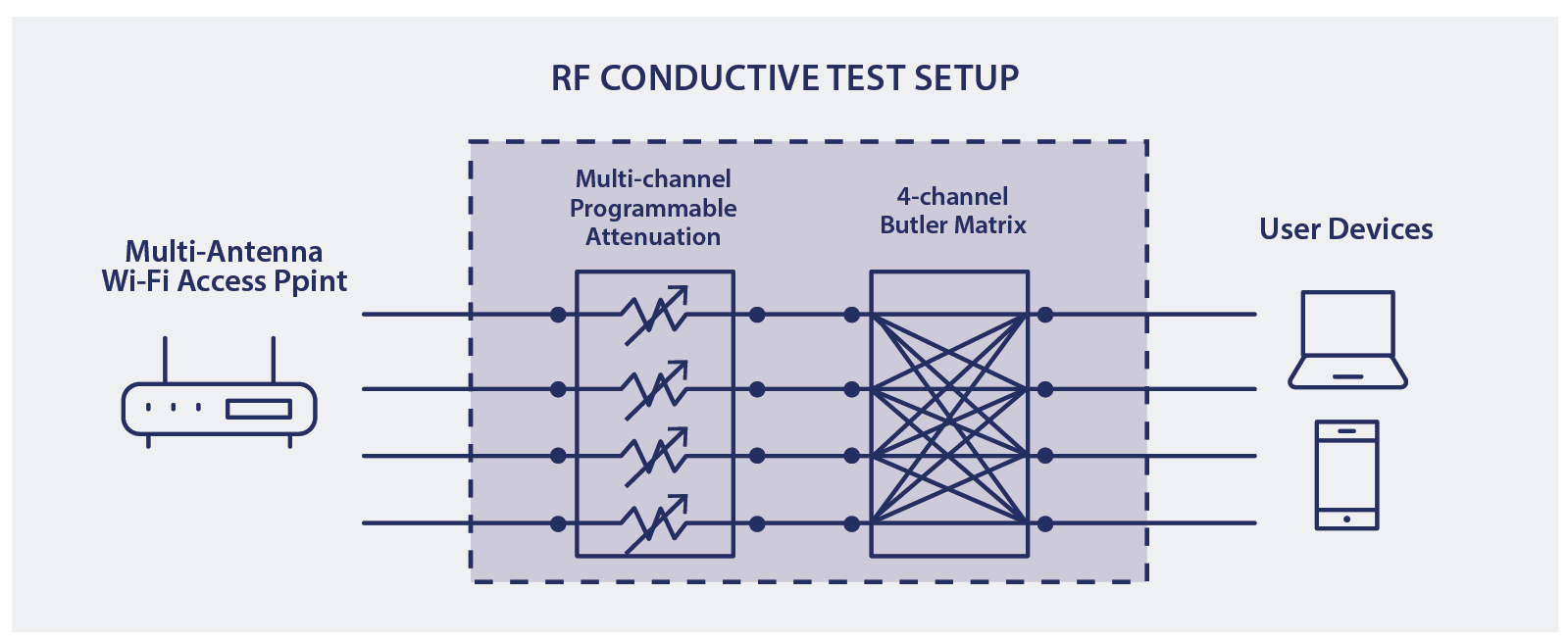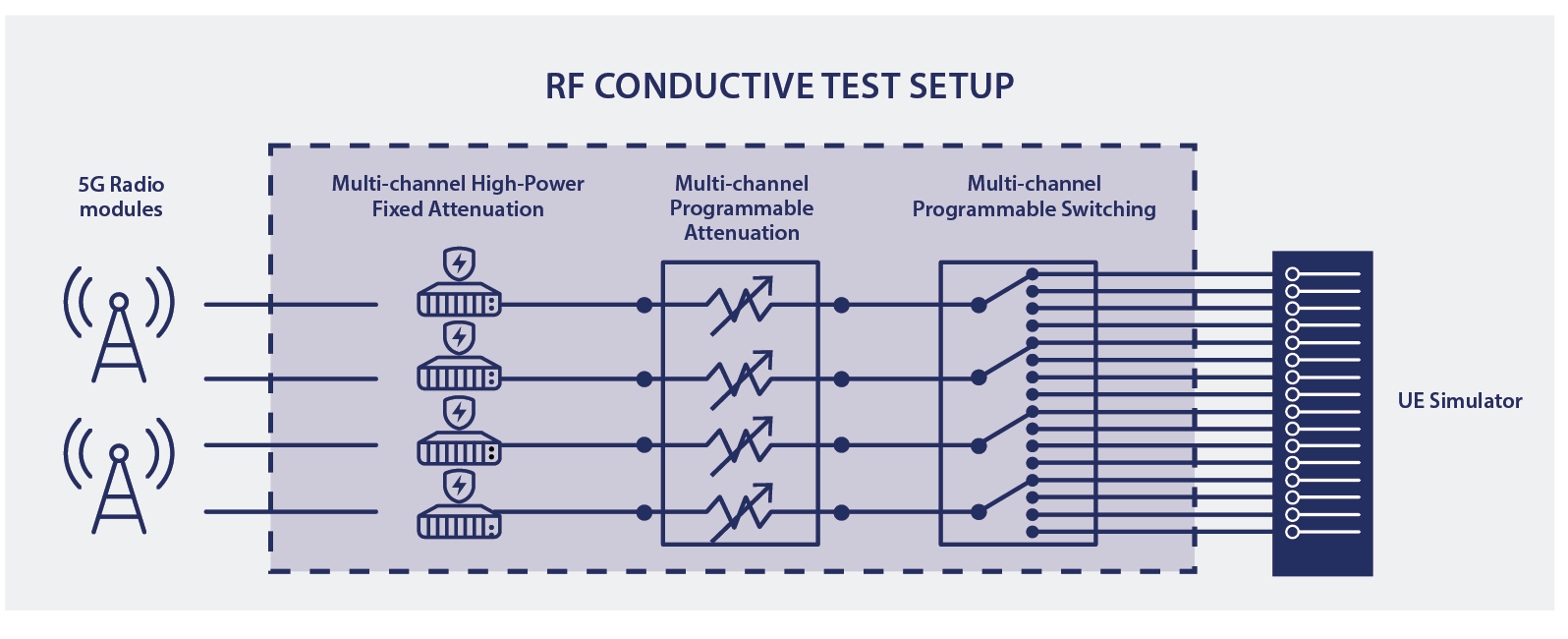Wireless Test Environments
Get there.
Most RF Test environments start with solving simple test-cases, such as throughput testing, handover, fading etc. These conductive test cases are built using basic functional test blocks such as programmable attenuators, Butler Matrices, coaxial connectors and adapters. As test-cases evolve and become more complex and the number of test devices scale up, the complexity of the test-cases also become higher.
Today’s wireless test environments require smart bundling of sub-system testing functionality necessitating tighter integration between sub-systems . At this stage manual control of the individual test blocks is no longer feasible. The user requires a single interface to have the ability to control a variety of parameters across the different systems within the test suite. Advanced software control is used to automate the various test cases. The ultimate goal of the RF Conductive Test Environments provided by Spectrum Control is full digital transformation:
- Integrated test environments
- Software control and automation
- Support for advanced test cases such as multipath, Doppler interference, Massive MIMO etc.

Ensuring wireless connectivity performance is
fundamental for realizing the vision of 5G and
Wi-Fi 6E technologies.

Throughput Testing

Test the throughput of multiple wireless devices (5G and Wi-Fi) at various transmit and receive power levels. This can be adapted for testing any other wireless technologies such as 5G, LTE, Bluetooth, and Zigbee, for example. Test for throughput, jitter, packet error rate vs range, device orientation and more.
Certification Testing

This RF conductive test setup emulates an outdoor LTE/5G wireless environment with a 5G/LTE Radio
and user devices or a UE simulator. This setup is used to simulates the fading loss between the radios and the user devices/UE simulator. The test allows you to connect multiple radios to multiple user-devices and control signal coordination to the devices under test. This RF Testbed can also be adapted for testing any other wireless technologies such as Wi-Fi, Bluetooth, Zigbee etc. as well.
Hybrid Testing
Simultaneously support conductive and hybrid over-the-air (OTA) tests with multiple radios connected to a single antenna. We use a butler matrix to produce a channel condition number of 1, maximizing throughput. Add a multipath emulator to reproduce multipath conditions in the Wi-Fi 6E frequency bands.

Test the throughput of multiple wireless devices (5G and Wi-Fi) at various transmit and receive power levels. This can be adapted for testing any other wireless technologies such as 5G, LTE, Bluetooth, and Zigbee, for example. Test for throughput, jitter, packet error rate vs range, device orientation and more.

This RF conductive test setup emulates an outdoor LTE/5G wireless environment with a 5G/LTE Radio
and user devices or a UE simulator. This setup is used to simulates the fading loss between the radios and the user devices/UE simulator. The test allows you to connect multiple radios to multiple user-devices and control signal coordination to the devices under test. This RF Testbed can also be adapted for testing any other wireless technologies such as Wi-Fi, Bluetooth, Zigbee etc. as well.
Simultaneously support conductive and hybrid over-the-air (OTA) tests with multiple radios connected to a single antenna. We use a butler matrix to produce a channel condition number of 1, maximizing throughput. Add a multipath emulator to reproduce multipath conditions in the Wi-Fi 6E frequency bands.
Multipath Testing
models multipath in a Wi-Fi environment with a power delay path matching the IEEE TG-n channel model. This test environment supports class B (indoor) NLOS and Expand Line of Sight (LOS) models, along with class D (outdoor) Expand Non-Line of Sight (NLoS) operation. An on-board phase shifter provides the ability to exercise the DUT under the full range of multipath conditions (both destructive and constructive interference).
Handover Testing
The RF conductive test setup emulates an outdoor LTE/5G wireless environment, with a 5G/LTE Radio and user devices and allow you to test for the handover between base stations or access points. The radios under test are connected to power dividers/combiners, then into multi-channel programmable attenuators. Finally, the signal is routed to a number of user-devices. Motion can be emulated by ramping the attenuators to introduce signal fading loss versus time. The ramping rate can be accurately controlled to emulate typical velocity of mobile devices when in vehicles.
Mesh Connectivity Testing
Test Mesh Node Placements and the formation of dynamic routing connections for point-to-point or end-to-end environments ensuring that data and applications can be securely delivered and controlled across a wide range of environments. You can also test Station Moving Patterns moving between nodes sequentially, jumping out of sequence etc. The Load Patterns test looks at fixed and mobile devices moving around the business premieres handing over between nodes running data, confirming that data and applications can be securely delivered and controlled across the mesh network environments.
models multipath in a Wi-Fi environment with a power delay path matching the IEEE TG-n channel model. This test environment supports class B (indoor) NLOS and Expand Line of Sight (LOS) models, along with class D (outdoor) Expand Non-Line of Sight (NLoS) operation. An on-board phase shifter provides the ability to exercise the DUT under the full range of multipath conditions (both destructive and constructive interference).
The RF conductive test setup emulates an outdoor LTE/5G wireless environment, with a 5G/LTE Radio and user devices and allow you to test for the handover between base stations or access points. The radios under test are connected to power dividers/combiners, then into multi-channel programmable attenuators. Finally, the signal is routed to a number of user-devices. Motion can be emulated by ramping the attenuators to introduce signal fading loss versus time. The ramping rate can be accurately controlled to emulate typical velocity of mobile devices when in vehicles.
Test Mesh Node Placements and the formation of dynamic routing connections for point-to-point or end-to-end environments ensuring that data and applications can be securely delivered and controlled across a wide range of environments. You can also test Station Moving Patterns moving between nodes sequentially, jumping out of sequence etc. The Load Patterns test looks at fixed and mobile devices moving around the business premieres handing over between nodes running data, confirming that data and applications can be securely delivered and controlled across the mesh network environments.